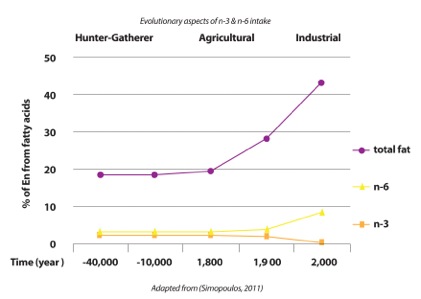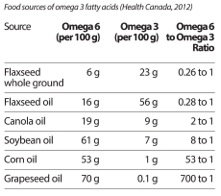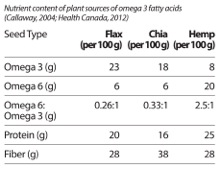August 31, 2015 Demystifying the Omega 6 and Omega 3 Debate
Source:
Jennifer Adolphe, PhD, RD and Kelley Fitzpatrick, MSc
| Category:
Health & Nutrition
The Omega 6 and Omega 3 Debate
Supported by solid scientific findings and increasing consumer interest, the market for omega 3 (n-3) fatty acids is growing at an impressive rate. Two of the most popular sources for n-3s are flaxseed and fish oil, either from whole foods or supplements. Flaxseed contains over 50% of its fatty acids as n-3 alpha-linolenic acid (ALA), making it the richest plant source of this essential fatty acid. Whole ground flaxseed is also a good source of health-promoting lignans, antioxidants and fiber. Fish oils are sources of the long-chain n-3s -- eicosapentaenoic acid (EPA) and docosahexaenoic acid (DHA).
Alongside the positive attributes of n-3 fatty acids are unfortunate and often confusing messaging around the health effects of the specific n-3s, particularly the physiological significance of plant-based ALA “versus” fish-based EPA and DHA. What many fail to recognize is the critical need for dietary intake of all three types of n-3s, especially given the increasing predominance of omega 6 (n-6) fatty acids in the diet. In the continuing debate surrounding the health effects of n-3 fatty acids, it is unfortunate that ALA does not receive the attention it deserves. For more information on the health benefits of ALA, download our Health Benefits of α-Linolenic acid from Flaxseed factsheet.
ALA and its counterpart n-6 essential fatty acid, linoleic acid (LA), are converted in our bodies to longer-chain fatty acids including EPA and DHA (from ALA) and arachidonic acid (AA, from LA). These fatty acids are then incorporated into cell membranes and used to make other molecules that are critically important for the regulation of various processes in the body. The amount and type of these molecules produced is dependent upon dietary factors – that is the amount of n-6 and n-3 that are consumed. This is the focus of this newsletter.
The Evolution of Dietary Omega-3 Fatty Acids
Our modern diets are extremely lacking in n-3 fatty acids. In fact, more than one-third of adults are likely not getting the recommended amount of essential ALA (Papanikolaou, Brooks, Reider, & Fulgoni, 2014). And children are probably no better off as well. Prior to the industrial revolution, the intakes of n-3 and n-6 were approximately equal (1 to 1 ratio), but today our diets have significantly changed resulting in a very high n-6 to n-3 ratio (16:1 or greater; see Figure 1). Only a couple of generations ago, our ancestors were not plagued with the diet-associated chronic diseases – heart disease, diabetes, cancer, obesity – that are so prevalent today, with the change in dietary fat intake (and thus the ratio) likely being a major contributor.
Not only do our modern diets include a lot less n-3, but we are eating a lot more n-6 due to its abundance in our food supply, primarily from soybean oil, especially in the U.S. (Blasbalg, Hibbeln, Ramsden, Majchrzak, & Rawlings, 2011). Canadians maybe somewhat better off as we eat a lot of canola oil which has a more favorable n-6 to n-3 ratio (2:1; Figure 3). The good news is that with the help of flaxseed and flaxseed oil which contains almost four times more ALA than LA, we can return to eating a diet that more closely resembles that of our ancestors and greatly improve our dietary n-6 to n-3 ratio (Figure 3).
The Omega 3 & 6 Balancing Act
ALA can be converted to longer chain EPA and DHA in the body. However, ALA and LA both compete for the same conversion enzymes (Figure 2), so the types of fat in our diet directly impacts our ability to make EPA and DHA from ALA. The ratio of dietary n-6 to n-3 matters, but so does the total amount of each type of fatty acid. A diet rich in LA may reduce the conversion of ALA to EPA by as much as 40% (Emken, Adlof, & Gulley, 1994). Lower LA intake has a two-pronged beneficial effect on fatty acid metabolism by significantly increasing EPA synthesis in addition to reducing n-6-derived arachidonic acid (AA) synthesis. (Liou, King, Zibrik, & Innis, 2007). AA is the precursor of powerful eicosanoids (hormone-like compounds), several of which promote the clumping (aggregation) of blood platelets, the clotting of blood within blood vessels (thrombosis) and inflammatory reactions. It’s all about balance – a diet high in n-6 and low in n-3 will increase inflammation; a diet with less n-6 and more n-3 will reduce inflammation.
A recent study highlighted the impact dietary n-6 fatty acids have on EPA and DHA status (Wood et al., 2014). For two weeks, study participants were instructed to continue to eat their habitual diet (control diet). Then, for four weeks, participants consumed a low LA diet while maintaining saturated fat intake at < 10% of energy and not altering intake of EPA and DHA from baseline. The changes in dietary intake and their effect on plasma and red blood cell phospholipids were then analyzed. The results showed that daily LA intake on the control and low LA diets were 8.5 g and 4.2 g, respectively. EPA and DHA intake did not change between the two diets, while ALA intake actually decreased slightly on the LA diet compared to the control diet (1.23 g to 0.57 g per day). In spite of lower ALA intake, the EPA and DHA content of plasma phospholipids significantly increased with the low LA diet, demonstrating that reducing LA for four weeks positively affects EPA and DHA status (Wood et al., 2014). In other words, preventing overconsumption of LA may be just as important as ensuring adequate ALA intake in maintaining EPA and DHA status.
ALA appears to provide its own health benefits, unrelated to its conversion to EPA and DHA (Fleming & Kris-Etherton, 2014; Kim, Nam, Kim, Hayes, & Lee, 2014). So, grab some flaxseed and give your diet an ALA boost! Flax oil is by far the richest source of ALA among the common vegetable oils available today (Figure 3). Also, flaxseed is even higher in ALA than other so-called ‘superfoods’ that are popping up on store shelves (Figure 4). Given the increased concerns over agricultural sustainability and depletion of marine food sources, ALA from flaxseed provides health benefits as well as some unique advantages over n-3 fatty acids from fish. The limited global availability, high cost, allergies, taste preferences and toxins associated with fish oil are of much less concern with n-3 rich plant sources such as flaxseed.
The Bottom Line
It’s important to realize that this is a long-term process. Most people are storing an abundance of n-6 fatty acids in their body fat stores and it can take years to get rid of them.
This is a simple guide to optimize your balance of the omega fats:
1. Avoid vegetable oils high in n-6 (and the processed foods that contain them).
2. Eat plenty of n-3 rich seeds such as flax as well as fish products.
3. If needed, supplement with an n-3 source like flaxseed oil.
Figure 1: Evolutionary aspects of n-3 & n-6 intake

Figure 2: Conversion of ALA and LA to metabolic factors involved in inflammation

Figure 3: Food sources of omega 3 fatty acids(Health Canada, 2012)

Figure 4: Nutrient content of plant sources of omega 3 fatty acids(Callaway, 2004; Health Canada, 2012)

References
- Blasbalg, T. L., Hibbeln, J. R., Ramsden, C. E., Majchrzak, S. F., & Rawlings, R. R. (2011). Changes in consumption of omega-3 and omega-6 fatty acids in the United States during the 20th century. American Journal of Clinical Nutrition, 93(5), 950-962. doi: 10.3945/ajcn.110.006643
- Callaway, J. C. (2004). Hempseed as a nutritional resource: An overview. Euphytica, 140, 65-72.
- Emken, E. A., Adlof, R. O., & Gulley, R. M. (1994). Dietary linoleic acid influences desaturation and acylation of deuterium-labeled linoleic and linolenic acids in young adult males. Biochimica et Biophysica Acta, 1213(3), 277-288.
- Fleming, J. A., & Kris-Etherton, P. M. (2014). The evidence for alpha-linolenic acid and cardiovascular disease benefits: Comparisons with eicosapentaenoic acid and docosahexaenoic acid. Adv Nutr, 5(6), 863s-876s. doi: 10.3945/an.114.005850
- Health Canada. (2012). Canadian Nutrient File. Retrieved August 3, 2015, from http://webprod3.hc-sc.gc.ca/cnf-fce/index-eng.jsp
- Kim, K. B., Nam, Y. A., Kim, H. S., Hayes, A. W., & Lee, B. M. (2014). alpha-Linolenic acid: Nutraceutical, pharmacological and toxicological evaluation. Food and Chemical Toxicology, 70c, 163-178. doi: 10.1016/j.fct.2014.05.009
- Liou, Y. A., King, D. J., Zibrik, D., & Innis, S. M. (2007). Decreasing linoleic acid with constant alpha-linolenic acid in dietary fats increases (n-3) eicosapentaenoic acid in plasma phospholipids in healthy men. Journal of Nutrition, 137(4), 945-952.
- Papanikolaou, Y., Brooks, J., Reider, C., & Fulgoni, V. L., 3rd. (2014). U.S. adults are not meeting recommended levels for fish and omega-3 fatty acid intake: results of an analysis using observational data from NHANES 2003-2008. Nutrition Journal, 13, 31. doi: 10.1186/1475-2891-13-31
- Simopoulos, A. P. (2011). Evolutionary aspects of diet: the omega-6/omega-3 ratio and the brain. Molecular Neurobiology, 44(2), 203-215. doi: 10.1007/s12035-010-8162-0
- Wood, K. E., Lau, A., Mantzioris, E., Gibson, R. A., Ramsden, C. E., & Muhlhausler, B. S. (2014). A low omega-6 polyunsaturated fatty acid (n-6 PUFA) diet increases omega-3 (n-3) long chain PUFA status in plasma phospholipids in humans. Prostaglandins Leukotrienes and Essential Fatty Acids, 90(4), 133-138. doi: 10.1016/j.plefa.2013.12.010